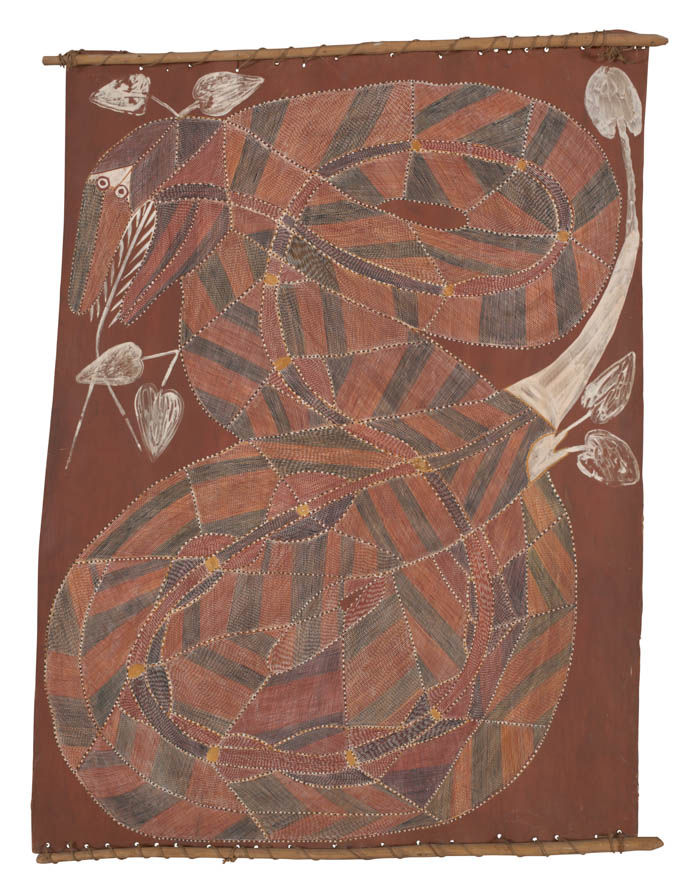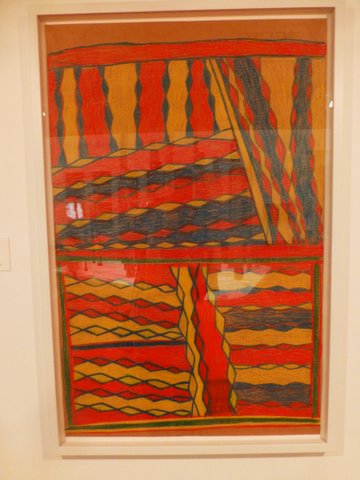Aboriginal Art
 Contemporary Aboriginal dancers
Contemporary Aboriginal dancers
 |
 |
I am not an expert on Aboriginal art, but I taught for 15
years at the Australian National University, during which I
taught Australian art and my husband worked at the
Australian Institute of Aboriginal and Torres Strait
Islander Studies. So we were very involved with
Aboriginal issues and Aboriginal art during an eventful
time.

Aboriginal languages:
"In the late 18th century, there were
more than 250 distinct Aboriginal social
groupings and a similar number of languages or
varieties. At the start of the 21st century, fewer than
150 Aboriginal languages remain in daily use, and
all except only 13, which are still being transmitted to
children, are highly endangered."
--no permanent settlements, very little material
culture--what used to be called “hard primitivism” as
opposed to the “soft” primitivism of Polynesians, for
example
--some 200 distinct languages, as many as a thousand
dialects of these

Prime Minister Gough Whitlam pours soil into the hands of
traditional land owner Vincent Lingiari, 16 August
1975, Northern Territory. This is the historical
moment that is the theme of Paul Kelly's great song, "From
Little Things Big Things Grow". Lignari led the strike by
Aboriginal stockmen to reclaim their traditional land,
beginning the process of overturning the concept of "terra
nullius".


EX: Eddie Mabo with the Torres Strait Islander flag
and in later life:
Eddie Mabo (c. 29 June 1936 – 21 January 1992[1])
was an Indigenous Australian
man from the Torres Strait Islands
known for his role in campaigning for Indigenous land rights
and for his role in a landmark decision of the High Court of Australia
which overturned the legal doctrine of terra nullius ("nobody's
land") which characterised Australian law with regard to
land and title.[From Wikipedia]
One of the continuing vexed issues: is the production
of "artworks" by Aboriginal people properly placed in the
realm of ethnography or can it be seen as fine art in the
Western art tradition?
--art market’s implications for tribal, indigenous people --what are we to make of our AESTHETIC response, as non-indigenous people, to images that for the maker have very different meanings?
Aborigines have been in Australia for 40-60,000 years, and
are considered by many to be the oldest enduring and
continuous culture. Aboriginal Australians are descendents
of the first people to leave Africa up to 75,000 years ago,
a genetic study has found, confirming they may have the
oldest continuous culture on the planet. IMPORTANT:
Aboriginal culture is NOT one culture, but consists of small
nomadic groups, each with own language--in some places with
populations as little as 1,000, three different languages
will co-exist.

Adrian Jangala Robertson, Yalpirakinu, 2020 (Telstra National Aboriginal and Torres Strait Islander Award winner).
He at Yuendumu, his paintings consistently refer to the desert mountain, ridges and tress which are part of Yalpirakinu, his home land.

Tjala Women's Collaborative, Nganampa Ngura, 2020 (Telstra National Aboriginal and Torres Strait Islander Award winner.
Note their utter remoteness! Nganampa Ngura means "Our Place".
Aborigines have, of course, been making “art”--that is, creating images--since ancient times, and their rock art paintings, which are still maintained and preserved, are believed to be among the oldest surviving imagery in the world. But "painting", as Westerners understand it, is, as we shall see, a very recent phenomenon.

EXS: Rock art--Wandjinas,
still cared for--one of most prominent Creation
myths. Wunnumurra Gorge, Barnett River. Kimberley,
Western Australia.

Wandjina at the Sydney Olympics, 2000
From Blue Guide:
"The regional Aboriginal rock paintings centre around
Wandjina spirits. Involved in the creation myths, these
wondrous fertility guardians bring the monsoons and cyclones
to ensure regeneration of life. They are in human form with
hair that is also the area’s large, white cumulonimbus
clouds. They can cause lightning to emanate from their
feathered headdresses. The Wandjina live the dry months of
the year in their self-portrait rock paintings. During The
Wet, the local Aboriginal people preserve them by retouching
the paintings while the Wandjina themselves are away tending
to the rains."
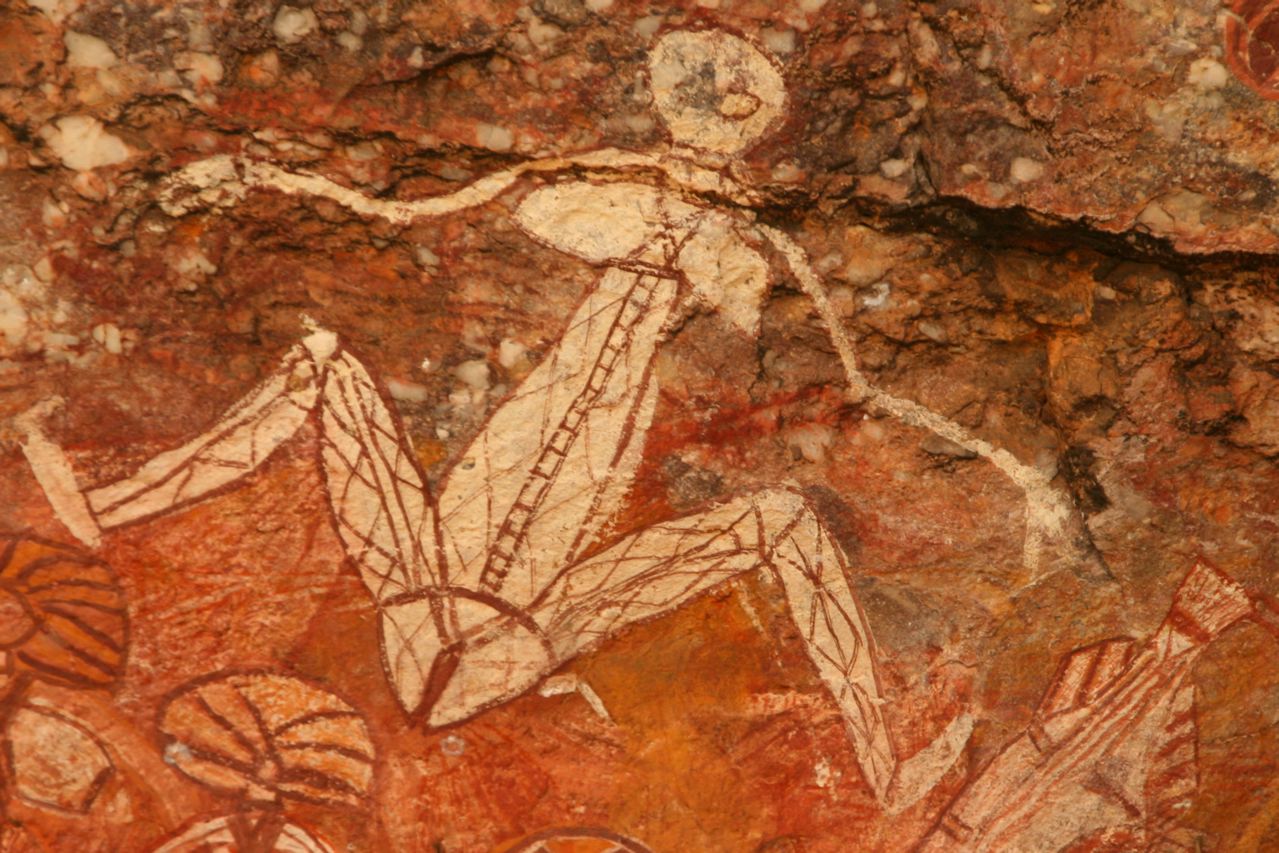 |
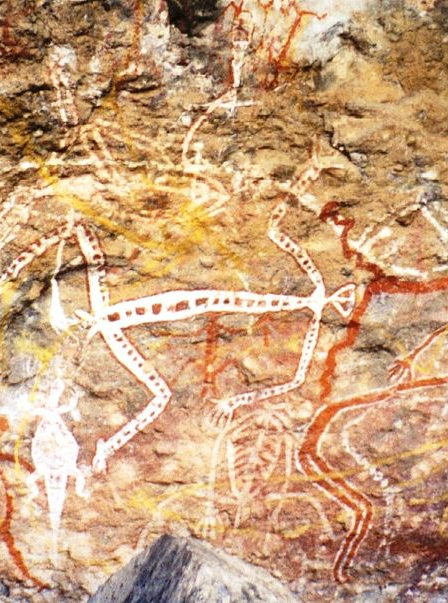 |
The rock art of the Kakadu region provides an interesting
insight into the process in which the convention of artistic
styles develop. Prior to the end of the last ice age, rock
art in Kakadu presented human and animal figures in animated
poses.
Bark paintings--used ceremonially to impart Creation
stories and initiation rites by some tribes of the
East--were found by famous explorer Baldwin Spencer in early
1900s
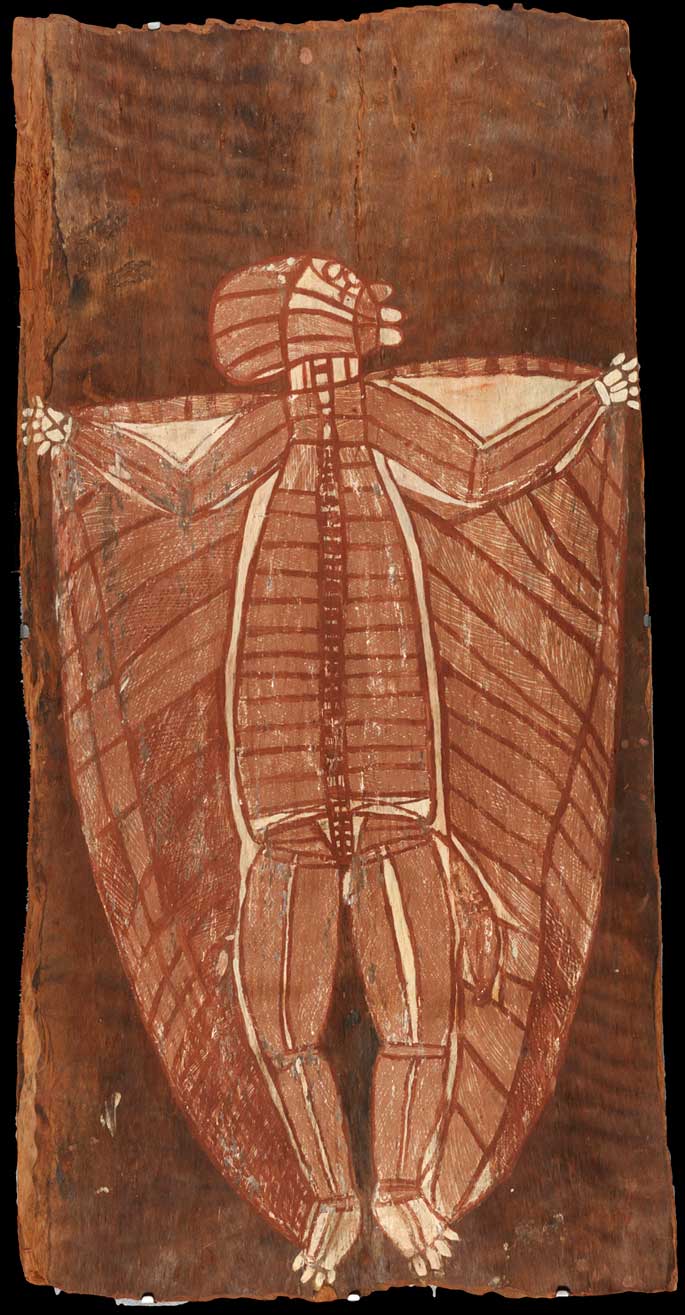 Bark painting collected 1912 by Spencer |
 Tjitjingalla Corroboree performed in Alice Springs, 1901 |
These images, and indeed almost all of Aboriginal art until very recently, were made for religious purposes--as telling parts of initiation stories--and were usually ephemeral, created in the sand or on the body as part of ceremonies
 Men in initiation body paint, Cox Peninsula, 1939, photo by Bill Nicholls |
 Postcard, early 20th century, showing staged Bora with sand painting, ca. 1910 |
[Bora is an initiation ceremony of the Aboriginal people of Eastern Australia, descended from groups that existed in Australia and surrounding islands before European colonisation. The word "bora" also refers to the site on which the initiation is performed. At such a site, boys, having reached puberty, achieve the status of men. The initiation ceremony differs from Aboriginal culture to culture, but often, at a physical level, involved scarification, circumcision, subincision and, in some regions, also the removal of a tooth.]
While the relative permanence of rock art makes it an
important means of dating the introduction of motifs and
styles, it was not the most frequently used medium. Painting
the bodies of celebrants in initiation and similar rites,
desert sand paintings not unlike horizontal frescos and
painted slabs of bark for the interior of dwellings were
from early days the most favoured media. Most of the motifs
found in bark and canvas paintings are secular variations on
the motifs in the consciously ephemeral body and sand
paintings.
Most important and the most cosmically ascetic aspect of Aboriginal imagery to understand: The Dreaming:
"When talking to an Aboriginal painter about a particular
work, he or she will first of all tell the visitor (as far
as the constraints of religious secrecy allow) about the
tjukurrpa (Dreaming), which is the painting’s source. He or
she will describe the specific interpretation which the
symbols assume in this story. The artist will point to the
tract of country in which the story takes place, often
naming the sites in great detail, and he will talk about the
custodianship of the area where the story is centred, naming
both specific contemporary custodians and the particular
subsection of the kin system through whom ownership is
generally passed down. For the artists, this is the
essential background information to the proper understanding
and appreciation of their work. A painting not informed by a
Dreaming (if such a thing were seriously possible) would be
nothing more than frivolous decoration; simply not art."
--Ian Green, ‘Make ’em flash, poor bugger’—-talking about
men’s paintings in Papunya in Margaret West, ed., The
Inspired Dream—Life as Art in Aboriginal Australia (1988).
Wally Caruana: “The Dreaming is a European term used by
Aborigines to describe the spiritual, natural and moral
order of the cosmos. It relates to the period from the
genesis of the universe to a time beyond living memory...The
terms do not refer to the state of dreams or unreality, but
rather to a state of reality beyond the mundane. The
Dreaming focuses on the activities and epid deeds of the
supernatural beings and creator ancestors such as the
Rainbow Serpents, the Lightning Men, the Wagilag Sisters,
...and Wandjina, who, in both human and non-human form,
travelled across the unshaped world, creating everything in
it and laying down the laws of social and religious
behavior....The Dreaming provides the ideological framework
by which human society retains a harmonious balance with the
universe--a charter and mandate that has been sanctified
over time.” (Caruana, Aboriginal Art, p. 10)
This is the framework in which we as Westerrners must consider Aboriginal art--all elements/motifs are totemic.
Aboriginal art is first and foremost representational--and, in most cases, the paintings tell a story that can have several layers of meaning.

EX: Tim Leura Tjapaltjarri, Sun, Moon and Morning Star
Tjukurrpa, 1973.
Many of its conventions are recognisable to the viewer.
Several fish of diverse species are shown caught in a large
fish trap or a kangaroo is presented in x-ray style, showing
its major organs and skeleton. With a bit of assistance the
viewer recognises the half doughnut shapes and bisected
angles in dot paintings as camp sites and emu tracks.
Beyond shared conventions, Aboriginal art in every region and in every style continues to be representational to those who understand its motifs
I want to focus on the two major styles, connected to different regions of the country:
1) X-Ray style of Arnhem Land and Upper Northern Territory. In these works, the cross-hatch designs and colours represent totemic or kin groups associated with stewardship of a particular site. They can represent special relationships with the species or event depicted.
 John
Mawandjul, Kandakidi, Red Kangaroo, 1997)
John
Mawandjul, Kandakidi, Red Kangaroo, 1997)
John Mawandjul, Rainbow Serpent, 1991 |
 Lofty Nadjamerrek, Kolobarr, the Plains Kangaroo, 1980s. (depicting “rarrk”) |
Just as one learns representational conventions in order to interpret a painting, there are associated stories and observations learned by Aboriginal initiates. The extent of esoteric knowledge conveyed by the art, a painting for instance, depends upon the status of the observers. Still, a considerable amount of information about a painting is secular. The meaning of the cross-hatches, on the other hand, is not explained; they seem simply decorative to the uninitiated observer, while to the initiated and those skilled in looking, these signs take on additional representational and symbolic significance
Rainbow Serpent is a creation symbol story shared by
several tribes/groups, so it appears in many regions.
The serpent as a Creation Being is perhaps the oldest
continuing religious belief in the world, dating back
several thousands of years. The Rainbow Serpent features in
the Dreaming stories of many mainland Aboriginal nations and
is always associated with watercourses, such as billabongs,
rivers, creeks and lagoons. The Rainbow Serpent is the
protector of the land, its people, and the source of all
life. However, the Rainbow Serpent can also be a destructive
force if it is not properly respected. The most common
version of the Rainbow Serpent story tells that in the
Dreaming, the world was flat, bare and cold. The Rainbow
Serpent slept under the ground with all the animal tribes in
her belly waiting to be born. When it was time, she pushed
up, calling to the animals to come from their sleep. She
threw the land out, making mountains and hills and spilled
water over the land, making rivers and lakes. She made the
sun, the fire and all the colours.
Warmun community artist Rover Thomas’s magnificent
depiction of Cyclone Tracy, a black path through coloured
landscape, is easily recognised once its significance is
explained.
 Rover Thomas (Joolama), Cyclone Tracy, 1991, National Gallery of Australia, Canberra. |
|
Then on Christmas Eve 1974,
Cyclone Tracy destroyed Darwin. The city was regarded by
Aboriginal people of the Kimberley as the centre of
European culture and, as cyclones, rain and storms are
usually associated with ancestral Rainbow Serpents, elders
interpreted the event as the ancestors warning Aboriginal
people to reinvigorate their cultural practices. In
Thomas' painting, the black form represents the cyclone
itself gaining intensity as it heads towards Darwin. Minor
winds, some carrying red dust, are shown feeding into the
main image.

Mark
Rothko, #20, National Gallery of Australia, Canberra
“White fella paint like me, but he don’t
know how to use black”
As an example of how these paintings work in terms of
conveying through repeated motifs an important story for an
Aboriginal group, I will concentrate on Wagilag Sisters
story
Basic aspects of this story, this songline:
The story goes that the two Wagilag sisters, one of whom
was pregnant, were fleeing their home and were being
followed by clansmen. On their travels they come across many
animals and plants and brought them in to life by naming
them. Eventually, the Wagilag sisters set up camp beside a
fertile waterhole at Mirarrmina. There, one of the sisters
pollutes the waterhole and the pregnant sister gives birth,
which causes Wititj the python to wake up angry and
incensed. Wititj creates a storm on emerging from the
waterhole and attempts to wash the two Wagilag sisters in to
the well with his downpour (the first monsoon). The two
Wagilag sisters dance and sing sacred songs in an attempt to
diffuse the situation and keep them safe, but when the
sisters become too exhausted to continue, the python is able
to swallow them up (including child and dog)! However, soon
after, Wititj develops stomach pains and groans skywards
above the land where he attracts the attention of other
great snakes who also rise up in to the sky. The great
snakes talk and they discover they all have different names
but they wonder why the python is ill. Realising he made a
mistake, Wititj lies about what he has just eaten but the
pain becomes so unbearable Wititj falls back to the land and
vomits up the sisters who regain their life from the
stinging bites of caterpillars. Undeterred, Wititj beats
them with clapsticks and eats them again. Later, the Wagilag
sister's clansmen, asleep in the hollow left by the python's
fall, were visited in their dreams by the sisters who
revealed to the clansmen the secrets of the songs and dances
which had been performed in an effort to stop the rainstorm.
SO: as the following images indicate, this story can be
told visually in a variety of ways, in which the recurring
motifs are easily "read" by those who know the story and the
significance of its parts.
 Dawidi Djulwarak, Wagilag Story, 1960. |
 Philip Gudthaykudthay, Wagilag Sisters with child, 2007.
|
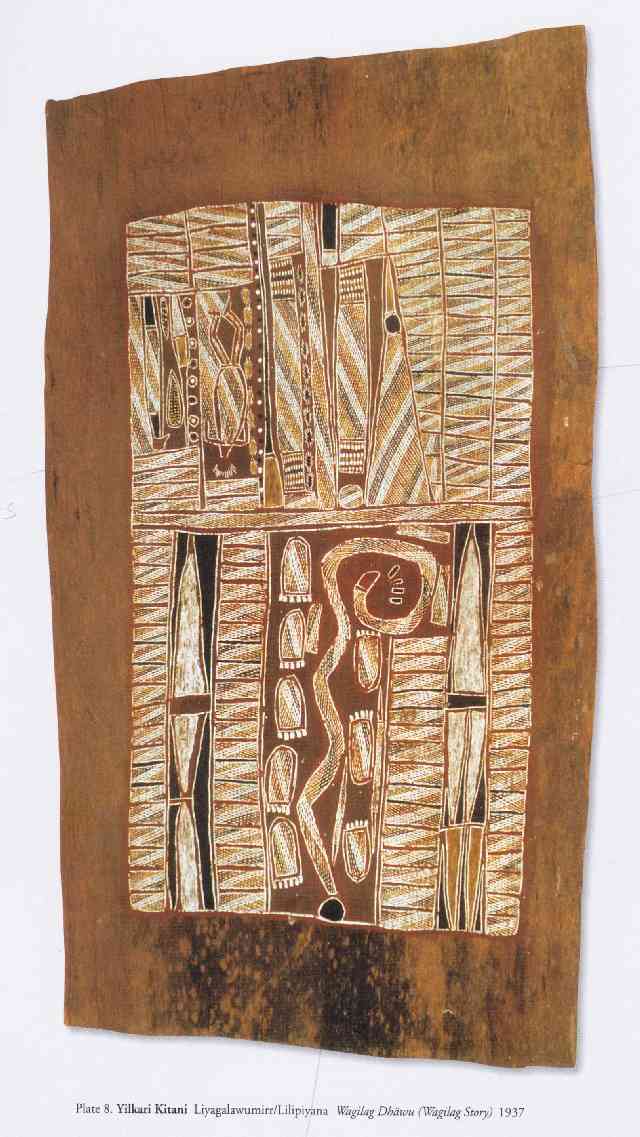 Yilkari Kitani, Wagilag Story, 1937. |
 Yilkari Kitani painting this very bark 1937. |
The other great stylistic development that most of us
recognize as Aborigianl art are the so-called “dot
paintings” of the desert communities.

|
 Dawidi's Wawiki |
 Mick Namarari Tjapaltjar, Women's Dreaming [Women's Dreaming (No.27)] c.1973 |  John Tjakamarra, no title, c. 1973. |
 Yumari, Uta-Uta-Tjangal, 2001. |  Hogan, Kungkarangalpa, det., 2013. |
Notice the development from earlier paintings to later ones. As with the x-ray style, until quite recently, these were generally religious and ephemeral, the work being done as ground (sand) paintings, body decoration or constructions. Public awareness of the forms in the desert depended upon photographs by ethnographers, which were first taken in the early 20C, or rock art and more transportable decorations on implements seen by visitors to the region willing to brave difficult travel.
**We can trace the beginnings of this style, and of what we
call contemporary Aboriginal art, to a single moment and place:
Papunya in the early 1970s.
Of course, there had been a recognition of some Aboriginal art
from earlier times, but collected by anthropologists and
ethnographers:
e.g. 1947 Yirkala drawings, made for the anthropologists Ronald
and Catherine Berndt on butcher paper--extraordinary example of early transmission
of Yirkala people’s storylines.
|  |
Bark painting began to be sold in the early 1960s. However, in
this case the impetus was from outstation missionaries who
attempted unsuccessfully to introduce watercolours. So, in
effect, Aboriginal art has been available to the wider public
since the 1960s. Of course, a number of anthropological and
gallery exhibits pre-date this by a century and more; German and
Swiss anthropological collections, such as the ethnographic
museum in Basel, were important archives of early Aboriginal
artefacts in Europe. The most important inaugural exhibition in
Australia was arguably the 1929 National Museum of Victoria’s
‘Primitive Art’ show, which included an anthropological display
of director Baldwin Spencer’s collection of bark paintings
acquired in 1912. But it was not until 1959 that any Australian
art gallery began to collect Aboriginal work as art rather than
as ethnographic artifacts, when the Art Gallery of New South
Wales under artist and curator Tony Tuckson began to display
works by artists from Tiwi and Arnhem Land cultures.
 Tony Tuckson filming Tiwi poles, Art Gallery of New South Wales, Sydney, 1959. |  Tiwi poles in Art Gallery of New South Wales, Sydney, today. |
It wasn’t until the early 1970s that what we think of as modern Aboriginal art came to the attention of the broader world and entered into the elaborately monetized matrices of the art market.

Map
of Papunya region; note Papunya, Hermannsburg, Yuendumu.
The introduction of acrylic paints to replace ground
ochres and other naturally occurring materials began in the
early 1970s at the Papunya School in central Australia. Geoffrey
Bardon, a teacher at the school, asked senior Aboriginal men in
the community for permission and advice on the Honey Ant
Dreaming for a mural at the school.
 Tribal elders and Honey Ant Mural, Papunya, NT, 1971. |  Geoffrey Bardon with Honey Ant Mural, Papunya, NT, 1972. |
Following considerable discussion about the propriety of
depicting sacred knowledge in a secular setting, Papunya elder
Old Tom Onion Tjapangati, who owned Honey Ant Dreaming, gave
permission to a number of local men to paint the mural. At about
the same time, Bardon provided artist board and paints and with
the help of Kaapa Tjampitjinpa, one of the mural painters who
had used modern materials, the Papunya men began painting in
acrylic on board. Initially, respect for ceremonial proprieties
caused more naturalistic depictions to replace the sacred
iconography. Eventually, recognition that conventional motifs
could be described without revealing sacred secrets allowed a
return to traditional style. Art board was quickly replaced by
the more portable unstretched canvas.

 Johnny Warangkula Tjupurrula, ater Dreaming, 1972. | 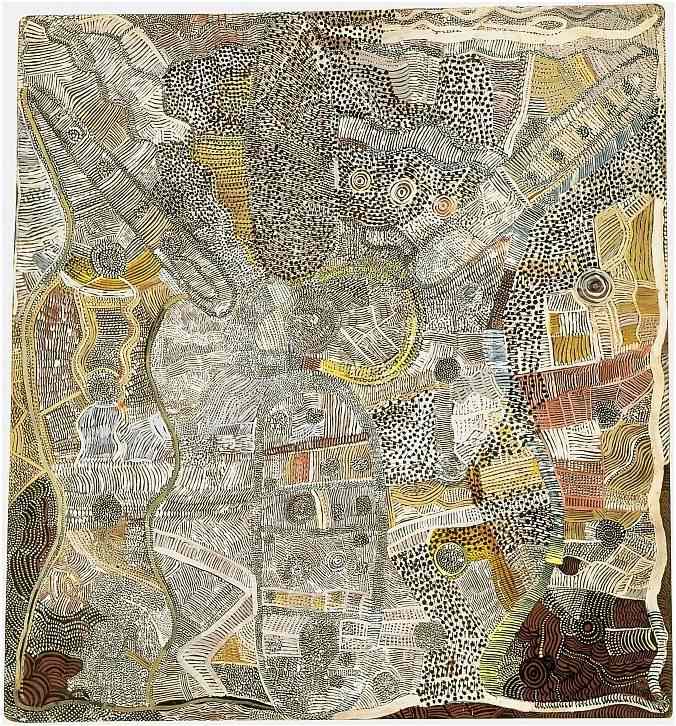 Johnny Warangkula Tjupurrula, Water Dreaming, 1972. |
Papunya and origin of dot paintings:
Bardon helped the Aboriginal artists transfer depictions of
their stories from desert sand to paint on canvas. They soon
realised that the sacred-secret objects they painted were being
seen not only by European, but also related Aboriginal people
which could be offended by them [5]. The artists decided to
eliminate the sacred elements and abstracted the designs into
dots [4,5] to conceal their sacred designs which they used in
ceremony.
During ceremonies Aboriginal people would clear and smooth over
the soil to then apply sacred designs which belonged to that
particular ceremony. These designs were outlined with dancing
circles and often surrounded with dots [2].
In the early years of Papunya paintings still showed clear
depictions of artefacts, sand paintings and decorated ritual
objects. But this style disappeared within a few years.
Uninitiated people never got to see these sacred designs since
the soil would be smoothed over again and painted bodies would
be washed. This was not possible with paintings. Consequently
Aboriginal artists abstracted the sacred designs to disguise the
meanings associated with them.
Some paintings are layered, and while they probably appear
meaningless to non-Aborigines, the dot paintings might reveal
much more to an Aboriginal person depending on their level of
initiation.
The first paintings to come from the Papunya Tula School of
Painters weren’t made to be sold. Papunya Tula Artists manager,
Paul Sweeney, explains that they “were produced by people who
were displaced, and living a long way from their country. The
works were visual representations of their own being. They
painted sites that they belonged to and the stories that are
associated with those sites. Essentially they were painting
their identity onto their boards, as a visual assertion of who
they were and where they were from.” [3]
A similar series of events, but with a little more awareness of
the idea of selling art to the white community, brought the art
of the Warlpiri artists of the Northern Territory to the public
arena. In this instance, Terry Davis, principal of the Yuendumu
school asked senior men to paint the doors of the community’s
school in 1983.
|  |
 Sticks made by Yuendumu women, early 1980's |  |
The work would be public, and would be the basis for subsequent, saleable art which would not be ephemeral but would be purchased and would permanently leave the community. That it could subsequently be sold beyond benefit to the community or the artist was not an understanding at this point. In 1985, arrangements for the secularisation of the art were made in Yuendumu through the Warlukurlangu Artists Association, one of the first Aboriginal-run organisations to benefit from commercial sales of traditional artworks.
|
|
 Paddy Simms, Yuendumu, 1980s. |  Yuendumu door, Yuendumu, NT, 1983. |

Paintings by first Yuendumu artists, Nine of the
30 Yuendumu doors, now in South Australian Museum.

Yanjilypiri Jukurrpa (Star Dreaming), 1985. Artists Paddy Jupurrurla Nelson (Warlpiri people, 1919-1999) Paddy Japaljarri Sims (Warlpiri people, 1917-2010) ,and Kwentwentjay Jungurrayi Spencer (Warlpiri people, 1919-1990). Yuendumu artists have become some of the best known artists of the movement. This painting is on the cover of Wally Caruana's book.
 Pompidou exhibit catalog cover | 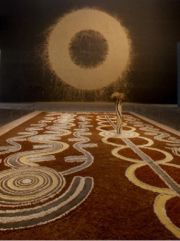 Yams in France |

One of the exhibit's rooms.
In 1989, six Yuendumu artists out of the Warlukurlangu Artists community installed a Yam Dreaming painting in the exhibition ‘Magiciens de la terre’ at the Centre Georges Pompidou in Paris. This exhibition marked a significant point in the recognition of Aboriginal art abroad, and in a ‘high art’ context rather than as ethnographic artifact. This exhibition was a huge turning point in the recognition of all indigenous art, from Africa and the Americas as well as Australia.
For Aboriginal art, the real beginnings of the ever-vexed interactions between ancestral imagery and the voracious Western art world.
 |
 |
Aboriginal art on display at Sydney gallery, Danks Street,
Waterloo, NSW, 2010.--in typical art gallery context:
white walls, framed, displayed as if Abstract Expressionism
This brings us to Emily Kngwarreye, the epitome of this
interaction.
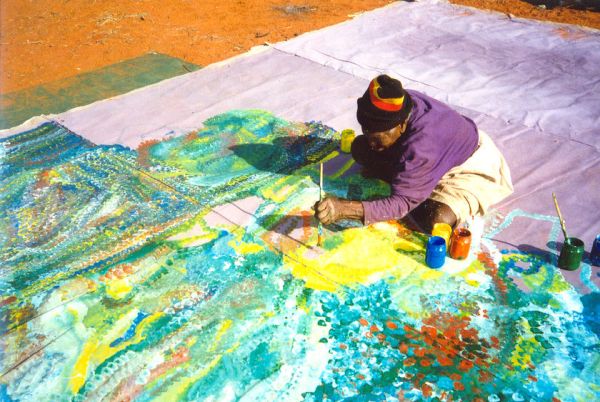
Born in 1910, Kngwarreye did not take up painting seriously
until she was nearly 80. She lived in the Anmatyerre language
group at Alhalkere in the Utopia community, about 250 km
north east of Alice Springs. Emily's initial artistic training
was as a traditional Indigenous woman, preparing and using
designs for women's ceremonies. Her training in western
techniques began, along with that of the rest of the Utopia
community, with batik. Her first batik cloth works were created
in 1980.[2] Later she moved from batik to painting on canvas:
"I did batik at first, and then after doing that I learned more
and more and then I changed over to painting for good...Then it
was canvas. I gave up on...fabric to avoid all the boiling to
get the wax out. I got a bit lazy - I gave it up because it was
too much hard work. I finally got sick of it...I didn't want to
continue with the hard work batik required - boiling the fabric
over and over, lighting fires, and using up all the soap powder,
over and over. That's why I gave up batik and changed over to
canvas - it was easier. My eyesight deteriorated as I got older,
and because of that I gave up batik on silk - it was better for
me to just paint."
Acrylic paintings were introduced to Utopia in 1988-89 by Rodney
Gooch and others of the Central Australian Aboriginal Media
Association.
Whereas the predominant Aboriginal style was based on the one
developed at the Papunya community in 1971 of many similarly
sized dots carefully lying next to each other in distinct
patterns, Kngwarreye created her own original artistic style.
This first style, in her paintings between 1989 and 1991, had
many dots, sometimes lying on top of each other, of varying
sizes and colours, as seen in Wild Potato Dreaming (1996).

Emily Kngwarreye, Earth’s Creation, 1994, Collection of Mbantua Gallery, Alice Springs, NT.
On 23 May 2007, her 1994 painting Earth's Creation was purchased by Tim Jennings of Mbantua Gallery & Cultural Museum for A$1,056,000 at a Deutscher-Menzies' Sydney auction, setting a new record an Aboriginal artwork. So the frenzy of dealers and get-rich-quick exploiters began.
With success came unwanted attention. Many other inexperienced
art dealers would go to her community to try to get a piece of
the action, Kngwarreye once describing to a friend how she had
"escaped from five or six carloads of 'wannabe' art dealers at
Utopia".
According to Sotheby's Tim Klingender, Emily was "an example of
an Aboriginal artist who was relentlessly pursued by
carpetbaggers towards the end of her career and produced a large
but inconsistent body of work."
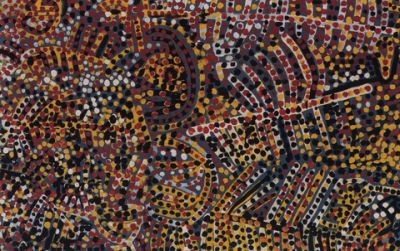 Emily Kngwarreye , Emu Woman 1988–89
Emily Kngwarreye , Emu Woman 1988–89
The Holmes à Court Collection, Heytesbury.
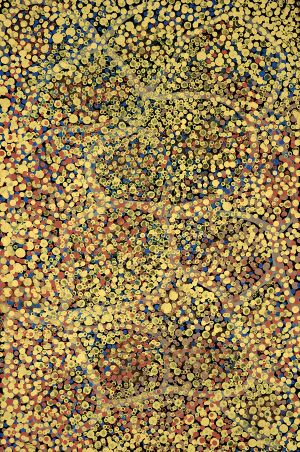 Emily Kngwarreye, Emu Tracks, 1991.
Emily Kngwarreye, Emu Tracks, 1991.
 Emily Kngwarreye, Arlatyite Dreaming (Pencil Yam),
1995.
Emily Kngwarreye, Arlatyite Dreaming (Pencil Yam),
1995.
 Emily Kngwarreye, Yam Dreaming, 1995.
Emily Kngwarreye, Yam Dreaming, 1995.
In 2008, a major exhibition of Emily’s work in Japan extremely
successful.
 Emily exhibition, Japan, 2008. |  Margo Neale at the Japan exhibition |
About the exhibition, patron Mrs. Holms a Court's statements were described thus: “Speaking at the blockbuster opening of the Emily Kame Kngwarreye exhibition in Tokyo last night, the patron of indigenous art declared that the debate about its value was also over. 'This exhibition takes the life out of the debate about indigenous arts versus non-indigenous art,' she said. 'Kngwarreye has been anointed as not just a great indigenous artist, which she is, but a great artist full stop.' Kngwarreye was 'up there with Monet, Modigliani and all the rest', Mrs Holmes a Court added. 'Raises enormous questions of artistic appreciation: critics scorning those who apply Western aesthetic standards to her work, insulting to take works out of ethnographic context, etc.'
What do we do with the fact that we as Westerners respond to
these works aesthetically? This question still rages, as
some still reject the idea that Westerners should be allowed to
treat these images as commodified art objects, rather than as
aspects of Aboriginal communities' religious practices.
Finally, one look at one Aboriginal artist who has been trained
in Western art, of which there are now many:
Lin Onus, some of the most iconic Australian pieces today.
 Lin Onus, Fruit Bats, 1991, Art Gallery of New South Wales, Sydney. |  Lin Onus, Fruit Bats, 1991, detail. |

Lin Onus, Dingoes, 1989, National Gallery of Australia, Canberra.
His themes are Aboriginal and political, but forms are Western--is this Aboriginal art?
Finally, another conundrum: Ginger Riley, a tribal artist but his style is frankly folk art--is this a further development of Aboriginal style?
 Ginger Riley Munduwalawala, This is my country – This is my story, 1992. |  Ginger Riley Munduwalawala Ngak Ngak in Limmen Bight Country, 1994. |
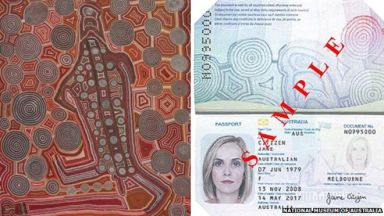 Australian
passport with Uta-Uta Tjangal’s Yumari design.
Australian
passport with Uta-Uta Tjangal’s Yumari design.
Finally, I will end with Harold Thomas, designer of the Aboriginal flag, which now flies everywhere in Australia.
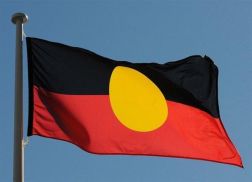 Aboriginal
Flag
Aboriginal
Flag
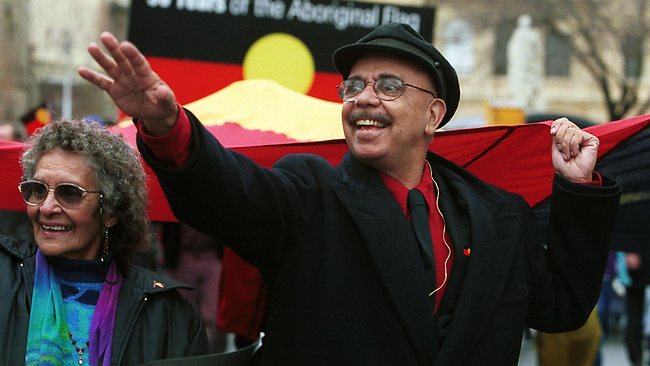
Harold Thomas, creator of the Aboriginal flag.
Harold Joseph Thomas (born c 1947) is an Indigenous Australian descended from the Luritja people of Central Australia. An artist and land rights activist, he is best know for designing and copyrighting the Australian Aboriginal Flag.
Thomas designed the flag in 1971 as a symbol of the Indigenous land rights movement. In 1995 the flag was made an official "Flag of Australia". He was later involved in a high-profile case in the Federal Court and the High Court to assert copyright over his design.
